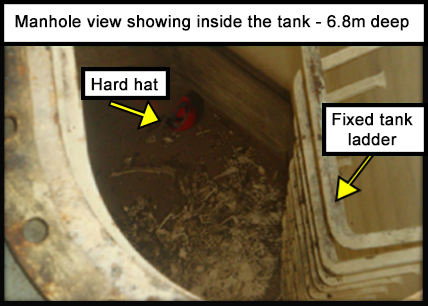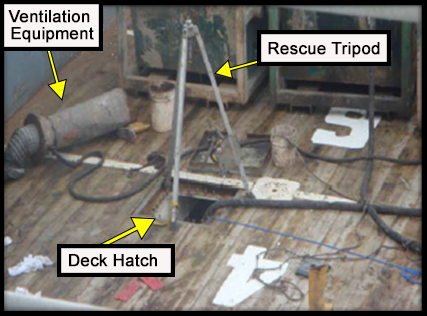-
What happened?
Three workers entered a vessel to clean water-based mud residue.
15 minutes after entry, the standby attendants heard shouts and an alarm was raised.
Rescuers with self-contained breathing apparatus retrieved the workers within 5 minutes, but all three workers had died.
It is believed they died of carbon monoxide poisoning or oxygen deficiency.

-
Why did it happen?
The work was carried out under permit, but:
- a gas reading had not been taken before entering.
- the tank had not been well ventilated.
- they were not required to use breathing apparatus.

-
What did they learn?
Complying with adequate work management standards would have mitigated high carbon monoxide or low oxygen hazards.
Confined space hazards must be identified prior to start work:
- hazardous atmosphere
- entrapment and engulfment hazards
- fire hazards
- other serious hazards
Ensure adequate barriers are in place:
- air testing
- permitting
- entrant training
- isolation
- rescue provisions

-
Ask yourself or your crew
What other actions could have been taken?
How can something similar happen on our site?
How do we ensure that all potential hazards are taken into account before issuing a work permit?
What controls do we have in place to prevent this today?
What improvements can we make to these controls?

Add to homescreen
Content name
Select existing category:
Content name
New collection
Edit collection
What happened?
Three workers entered a vessel to clean water-based mud residue.
15 minutes after entry, the standby attendants heard shouts and an alarm was raised.
Rescuers with self-contained breathing apparatus retrieved the workers within 5 minutes, but all three workers had died.
It is believed they died of carbon monoxide poisoning or oxygen deficiency.

Why did it happen?
The work was carried out under permit, but:
- a gas reading had not been taken before entering.
- the tank had not been well ventilated.
- they were not required to use breathing apparatus.

What did they learn?
Complying with adequate work management standards would have mitigated high carbon monoxide or low oxygen hazards.
Confined space hazards must be identified prior to start work:
- hazardous atmosphere
- entrapment and engulfment hazards
- fire hazards
- other serious hazards
Ensure adequate barriers are in place:
- air testing
- permitting
- entrant training
- isolation
- rescue provisions
Ask yourself or your crew
What other actions could have been taken?
How can something similar happen on our site?
How do we ensure that all potential hazards are taken into account before issuing a work permit?
What controls do we have in place to prevent this today?
What improvements can we make to these controls?
Three workers lost their lives during a vessel cleaning operation. It is believed they died due to carbon monoxide poisoning or oxygen deficiency.













